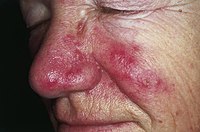
Photo from wikipedia
Abstract Background: Recent studies evidence that blue-LED-light irradiation can modulate cell responses in the wound healing process within 24 h from treatment. This study aims to investigate blue-light (410–430 nm)… Click to show full abstract
Abstract Background: Recent studies evidence that blue-LED-light irradiation can modulate cell responses in the wound healing process within 24 h from treatment. This study aims to investigate blue-light (410–430 nm) photobiomodulation used in a murine wound model within six days post-treatment. Methods: A superficial wound was made in 30 CD1 male mice. The injuries were treated with a blue LED light (20.6 J/cm2), and biopsies were collected at 24, 72, and 144 h. Histology, fluorescence analysis, and advanced microscopy techniques were used. Results: We can observe an increase in the cellular infiltrate response, and in mast-cell density and their degranulation index correlated to the expression of the major histocompatibility complex after 24 h. Furthermore, after six days, the vessel density increases with the expression of the platelet-derived growth factor in the mast cells. Finally, collagen deposition and morphology in the treated wounds appear more similar to unwounded skin. Conclusions: Blue-light photobiomodulation stimulates several cellular processes that are finely coordinated by mast cells, leading to more rapid wound healing and a better-recovered skin morphology.
Journal Title: Life
Year Published: 2022
Link to full text (if available)
Share on Social Media: Sign Up to like & get
recommendations!